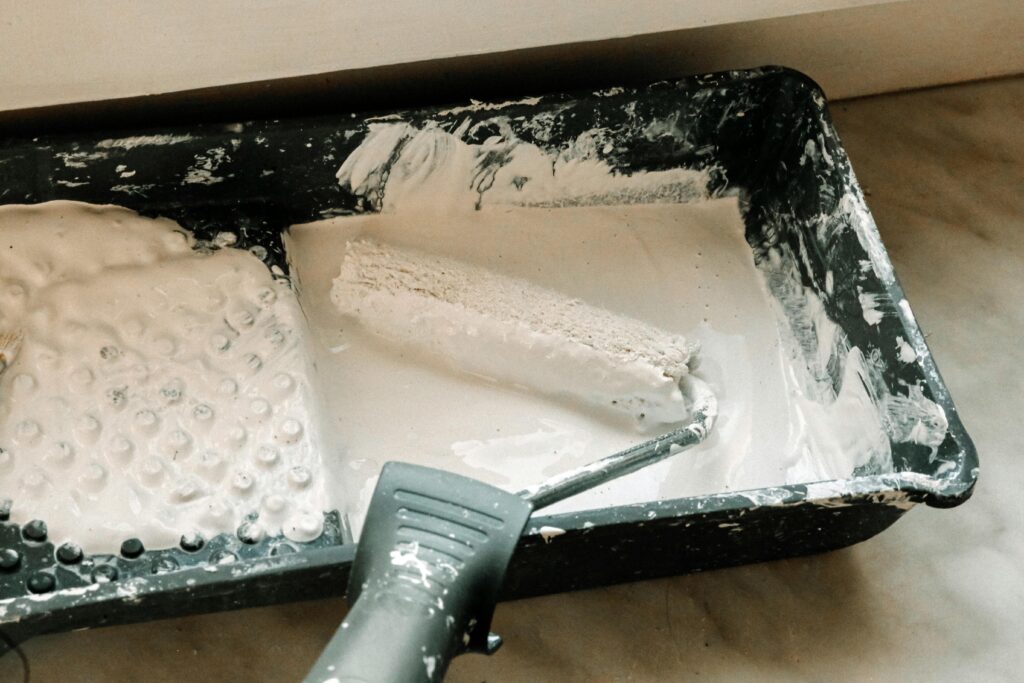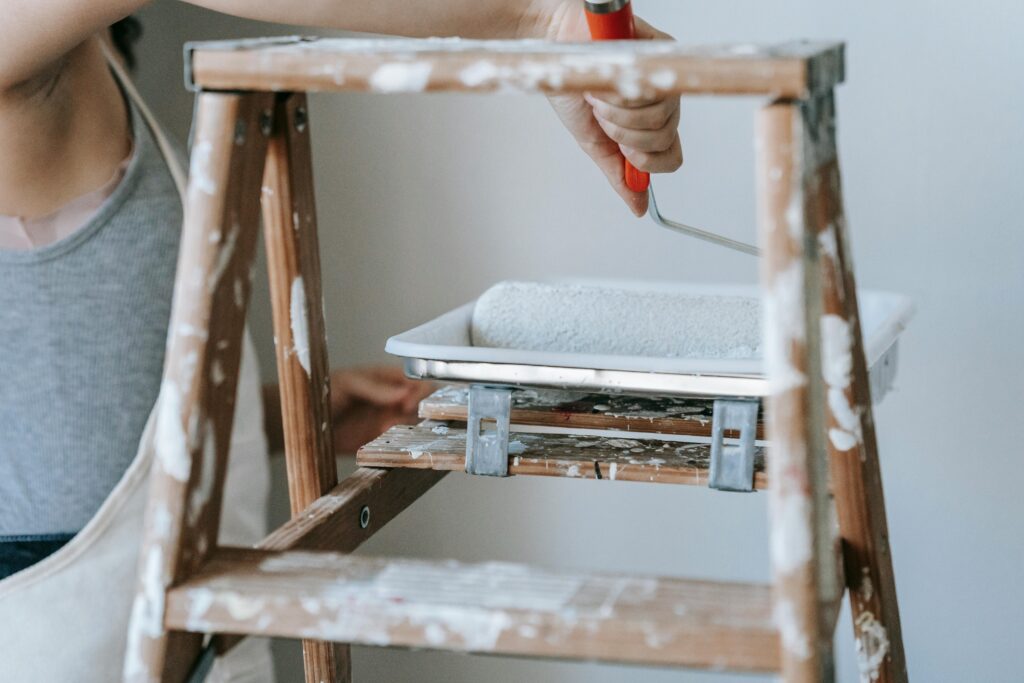This is precisely where our Guide to Residential Painting Colors and Techniques comes into play. Whether you’re a DIY enthusiast itching to pick up the brush or someone planning to hire professionals but wanting a clearer understanding of the process, this comprehensive guide will walk you through everything you need to know. From selecting the perfect palette that harmonizes with your décor and natural light, to mastering painting methods that guarantee a flawless finish, you’ll gain the confidence to transform your spaces like never before.
So if you’re ready to breathe new life into your living space, stick around as we dive deep into the art and science of residential painting colors and techniques.
Table of Contents
ToggleKey Takeaways
- Understand Color Psychology
- Prep Before Painting:.
- Select the Right Paint & Finish:
- Master Basic Techniques:
- Avoid Common Pitfalls:
- Use Small Test Patches
- Invest in Quality Tools
- Consider Accent Walls & Techniques
- Maintain Consistency
- Clean Up & Maintenance
Why a Complete Guide to Residential Painting Colors and Techniques Matters More Than You Think
When it comes to transforming a house into a home, nothing speaks louder than the colors on the walls and the techniques used to apply them. A guide to residential painting colors and techniques isn’t just about picking hues or wielding a brush; it’s about crafting an environment that reflects personality, boosts mood, and even enhances property value. But why exactly should homeowners, DIY enthusiasts, and professionals pay close attention to this comprehensive knowledge?
Residential painting is more than a cosmetic upgrade. According to a study by the National Association of Realtors, homes with freshly painted interiors in appealing colors sell 7% faster and command prices up to 5% higher than those without. This data underscores how strategic choices in colors and painting techniques can directly impact home appeal and economic value.
In essence, a complete guide to residential painting colors and techniques is the key to unlocking the full potential of home transformation. It empowers readers to make informed decisions, harness creativity, and ultimately live in spaces that inspire joy, comfort, and pride. Whether you’re a novice seeking simple tips or a seasoned decorator aiming for finesse, diving deep into this subject equips you with the tools to succeed.
How to Apply Residential Painting Techniques and Colors Step by Step
Embarking on a residential painting project can feel overwhelming, especially with the myriad of colors and techniques available. However, mastering the process step by step ensures a flawless finish that transforms your home’s ambiance. In this section of our Complete Guide to Residential Painting Colors and Techniques, we will walk you through a detailed, actionable process to apply colors and painting techniques effectively.
Step 1: Prepare Your Space Thoroughly
Before lifting a brush or roller, preparation is key:
– Clear the room: Remove furniture or cover it with drop cloths to protect from paint splatters.
– Clean the walls: Dust, grease, and grime hamper paint adhesion, so wash walls with mild detergent and water.
– Repair imperfections: Fill holes or cracks with spackle, let dry, then sand smooth.
– Tape edges: Use painter’s tape for trimming windows, baseboards, and ceiling lines to protect surfaces and ensure clean edges.
Example: Imagine meticulously taping a window frame before applying a bold coral hue on your living room walls, this careful preparation guarantees crisp borders free of smudges.
Step 2: Choose the Right Paint and Tools for Your Project
Selecting quality products boosts durability and appearance:
– Types of paint: Latex-based paints are common for interior walls due to low odor and quick drying; oil-based paints offer a glossy finish but require more ventilation.
– Finish selection: Matte finishes hide imperfections, whereas satin or semi-gloss provide easier cleaning and subtle sheen.
– Brushes and rollers: Use angled brushes for cutting edges and smooth rollers with the appropriate nap length depending on wall texture.
Step 3: Employ Painting Techniques Best Suited for Each Surface
Different walls and effects call for specific methods:
– Flat Walls: Apply paint using the “W” motion technique with a roller to create an even coat without streaks.
– Textured Surfaces: Use a thicker nap roller to reach crevices and ensure a uniform application.
– Accent Walls: Consider techniques like sponging or rag rolling to add depth and interest.
– Trim and Detail Work: Use smooth, angled brushes with steady hand strokes for a polished finish.
Step 4: Apply Primer and First Coat with Care
– Use primer: Priming ensures better paint adhesion and enhances color vibrancy, especially when painting over dark colors or stains.
– Apply the first coat: Start from corners and work your way across walls. Avoid overloading your brush or roller to prevent drips and patches.
Step 5: Add Additional Coats and Final Touches
– Second (and third) coats: Allow ample drying time between coats for a sturdy, rich finish. Some colors and surfaces may require multiple layers.
– Inspect and touch up: After the paint is dry, carefully check for missed spots or uneven areas and apply touch-ups as needed.
– Remove tape: Pull painter’s tape gently at a 45-degree angle to reveal clean lines without peeling paint.
Step 6: Clean Up and Maintain Your Painted Surfaces
– Clean tools immediately: Remove paint from brushes and rollers with proper solvents or water, depending on paint type.
– Maintain painted walls: Dust regularly and spot clean stains promptly to keep surfaces fresh and vibrant.
By following this step-by-step guide, painting your home with confidence becomes achievable. Not only do you ensure a beautiful outcome, but you also prolong the life and vibrancy of your walls. Remember, the right colors and techniques can turn any room into a welcoming masterpiece. Now, armed with these detailed instructions, you’re ready to bring your vision to life with residential painting colors and techniques that truly shine.
Next up: Discover expert tips on selecting the perfect color palettes for every room in your house.
Tips for the Complete Guide to Residential Painting: Colors and Techniques 🎨🏡
✅ Choose the Right Colors for Your Space:
Selecting colors that match the room’s purpose and lighting is crucial in residential painting. Soft blues create calm bedrooms, while vibrant yellows add energy to kitchens.
✅ Test Paint Samples Before Committing:
Always apply a small patch of the chosen colors in different lighting conditions to see how they change throughout the day. This step is essential in any complete guide to residential painting.
✅ Master Basic Painting Techniques:
Learn techniques like rolling, brushing, and cutting in for smooth and professional finishes. Your guide to residential painting should emphasize practicing these methods before starting.
✅ Prep Your Surfaces Thoroughly:
Cleaning, sanding, and priming walls ensure better paint adhesion and durability. Skipping this step can ruin your whole residential painting project.
✅ Choose the Right Paint Finish:
Matte finishes hide imperfections, semi-gloss is easy to clean, and satin offers a balance. Understanding finishes helps you achieve the perfect look in your residential painting guide.
✅ Use Quality Tools and Materials:
Invest in good brushes, rollers, and tape. Cheap tools can cause streaks and uneven surfaces, making your residential painting less effective.
✅ Consider Accent Walls or Patterns:
Adding an accent wall or simple patterns can transform a room dramatically. Your guide to residential painting must include creative ways to personalize spaces.
✅ Maintain a Consistent Color Palette Throughout the Home:
Stick to a cohesive color scheme to ensure harmony in your residential painting project. Jarring color changes can disrupt the flow of your home’s design.
✅ Understand Color Psychology:
Colors influence moods, blues calm, reds energize, greens refresh. Incorporating this knowledge elevates your complete guide to residential painting.
✅ Dry Time and Ventilation Matter:
Allow sufficient drying time between coats and ventilate rooms to avoid fumes. These practical tips prevent issues during your residential painting process.
By following these tips in your complete guide to residential painting: colors and techniques, you’ll create beautiful, lasting results that enhance your home’s appeal and value. Happy painting! 🖌️✨

Key Concepts
When we embark on the journey of residential painting, the process extends far beyond simply rolling a brush over a wall. It is an intricate dance between colors and techniques, each stroke carrying the potential to transform an ordinary space into a vibrant narrative of personality and mood. This dance is choreographed by essential concepts that form the backbone of every successful painting project.
The Language of Color: More than Meets the Eye
Color in residential painting is not merely about aesthetic appeal; it operates as a nuanced language that communicates emotions, influences perceptions, and even alters the ambiance of a space. Understanding color theory is akin to unlocking a secret code that governs our psychological and visual response to hues.
Consider color temperature: warm colors, reds, oranges, yellows, act like a cozy fireplace, emitting warmth and energy, fostering intimacy and vibrancy. Cool colors such as blues and greens serve as a refreshing breeze, instilling calmness and spaciousness in a room. This contrast is vital; it’s like choosing between the excitement of a summer’s day and the tranquility of a quiet lake at dusk. Each color shift can dramatically alter the story a room tells.
Moreover, the interplay of color harmonies, the relationships between colors on the spectrum, functions similarly to musical chords. Complementary colors clash and converge like a lively duet, grabbing attention and sparking energy. Analogous colors, close neighbors on the color wheel, create a soothing melody, blending seamlessly for a harmonious feel. Grasping these relationships helps paint not just walls, but moods.
Surface and Texture: The Canvas of Creativity
While color provides the story’s palette, the choice of surface and application technique determines its texture and depth, the very soul of the painted space. Every wall is a canvas textured with its own character: a smooth plaster wall whispers simplicity, whereas a rough stucco wall sings a rugged tale of rustic charm.
Techniques such as sponging, rag rolling, or stippling add layers of visual interest that can heighten or soften space perception. It’s comparable to a writer’s use of rhythm and meter, sometimes the prose is sharp and clipped; other times, flowing and poetic. The texture created by these paint techniques modifies how light interacts with the surface, casting shadows and highlights that bring colors to life, much like chiaroscuro in classical painting.
Understanding the physical quality of paint finishes, matte, satin, semi-gloss, and gloss, is equally pivotal. Each finish tells its own story: matte finishes absorb light softly, muting walls like a quiet whisper; gloss finishes reflect brightly, shouting boldness and vitality. This choice mirrors how a story’s tone can shift from gentle and introspective to loud and dramatic.
Psychological Impact: Painting as Emotional Architecture
Color and technique converge not only to beautify but to shape the emotional core of a home. Psychologically, paint colors influence behavior, mood, and even interpersonal interactions. A living room bathed in serene blues can evoke peace and deepen family bonds, while a fiery red kitchen might stimulate appetite and lively conversations.
This phenomenon is akin to the way a carefully crafted soundtrack can change the perception of a film scene. The paint becomes an emotional score, guiding inhabitants through feelings of comfort, energy, nostalgia, or renewal. Recognizing this invisible architecture of emotion enriches the role of residential painting, reminding us that homes are not mere structures but vivid landscapes of lived experience.
The Science of Durability: More than Surface Beauty
Beneath the artistry lies a world of chemical and material science. The durability of residential paint depends on factors such as solvent type, pigment quality, and weather resistance, concepts that bridge aesthetic intent with functional longevity.
For instance, latex-based paints, with their water-resistant properties, offer flexibility and ease of cleaning, much like a resilient fabric that withstands wear and tear. Oil-based paints might provide a richer finish but demand more maintenance, comparable to a delicate silk garment requiring careful handling. This scientific understanding ensures that the beauty crafted by color and texture withstands the passage of time, frame by frame, season by season.
Ultimately, the concepts of color theory, surface texture, psychological impact, and durability intertwine to form a complex tapestry. Residential painting, when approached with these foundational insights, becomes an artful symphony, where every brushstroke narrates a story of space transformed, moods shaped, and memories framed in vibrant hues.
Frequently Asked Questions (FAQs)
❓ What are the best color choices for residential painting?
Choosing the right colors depends on your home’s style, lighting, and personal taste. Neutrals like beige, gray, and white are versatile, while bold colors can highlight architectural features. Our guide helps you select colors that create the perfect ambiance.
❓ Which painting techniques are ideal for beginners?
For beginners, we recommend techniques like rolling and brushing, which are straightforward and effective. The guide also explains more advanced methods like sponging and rag rolling for adding texture once you gain confidence.
❓ How do lighting conditions affect color selection?
Lighting dramatically changes how paint colors look. Natural light makes colors appear truer, while artificial or dim lighting can alter hues. Our guide explains how to test colors in various lights before committing to your choice.
❓ Can I paint over existing paint without stripping it first?
In most cases, yes. If the old paint is in good condition with no peeling or cracking, you can paint over it after proper cleaning and priming. The guide offers step-by-step instructions for surface preparation to ensure lasting results.
❓ What tools are essential for a quality residential paint job?
Essential tools include high-quality brushes, rollers, painter’s tape, drop cloths, and a good primer. Our guide provides a complete list and tips on selecting tools that save time and improve finish quality.
These FAQs are designed to help you master residential painting by understanding colors and techniques, ensuring your painting project is a success from start to finish.



2 Responses